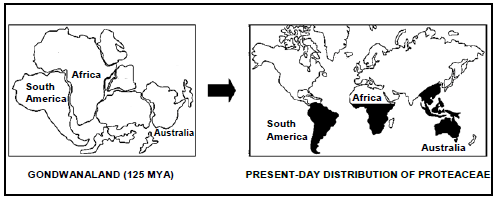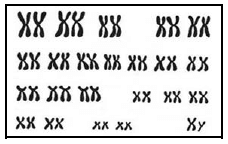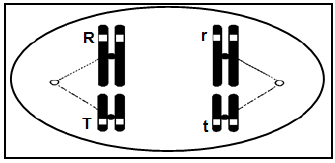LIFE SCIENCES PAPER 2 GRADE 12 QUESTIONS - AMENDED SENIOR CERTIFICATE PAST PAPERS AND MEMOS MAY/JUNE 2017
Share via Whatsapp Join our WhatsApp Group Join our Telegram GroupLIFE SCIENCES PAPER 2
GRADE 12
SENIOR CERTIFICATE EXAMINATIONS
MAY/JUNE2017
INSTRUCTIONS AND INFORMATION
- Read the following instructions carefully before answering the questions.
- Answer ALL the questions.
- Write ALL the answers in the ANSWER BOOK.
- Start the answers to EACH question at the top of a NEW page.
- Number the answers correctly according to the numbering system used in this question paper.
- Present your answers according to the instructions of each question.
- Do ALL drawings in pencil and label them in blue or black ink.
- Draw diagrams, tables or flow charts only when asked to do so.
- The diagrams in this question paper are NOT necessarily drawn to scale.
- Do NOT use graph paper.
- You must use a non-programmable calculator, protractor and a compass, where necessary.
- Write neatly and legibly.
SECTION A
QUESTION 1
1.1 Various options are provided as possible answers to the following questions. Write down the question number (1.1.1–1.1.10), choose the answer and make a cross (X) over the letter (A–D) of your choice in the ANSWER BOOK.
1.1.1 A genetic cross where both alleles of a gene are equally dominant is an example of …
- codominance.
- a dihybrid cross.
- incomplete dominance.
- complete dominance.
1.1.2 The list below describes features of evolutionary theories.
- Involves long periods of time during which species do not change
- Is always a gradual process
- Is supported by the absence of transitional fossils
- New species are formed in a short period of time
Which combination of features gives the correct characteristic of punctuated equilibrium?
- (i) and (iv) only
- (i), (iii) and (iv)
- (ii) and (iii) only
- (i) and (iii) only
1.1.3 The principles of inheritance were first outlined by …
- Gregor Mendel.
- Charles Darwin.
- Robert Broom.
- Watson and Crick.
1.1.4 Which ONE of the following is an example of non-disjunction?
- Colour-blindness
- Gene mutations
- Down syndrome
- Haploid gametes
QUESTIONS 1.1.5 AND 1.1.6 ARE BASED ON THE DIAGRAM BELOW.
Shrubs of the family Proteaceae (for example waratahs and proteas) can be found in Australia, South America, Indo-China and parts of Africa.
1.1.5 This type of evidence for evolution is called …
- the 'Out of Africa' hypothesis.
- fossil evidence.
- biogeography.
- cultural evidence.
1.1.6 It is evident from the diagram that all proteas …
- belong to the same species.
- are found in the Southern Hemisphere.
- became extinct when Gondwanaland separated.
- are equally distributed on all continents.
1.1.7 The diagram below shows the karyotype of an organism.
Study the following descriptions:
- There are 46 chromosomes.
- There are 46 autosomes.
- The 2 gonosomes are different from each other.
- The 2 gonosomes are identical.
Which combination of descriptions can be used to identify this karyotype as belonging to a normal, human male?
- (i), (iii) and (iv)
- (i) and (ii) only
- (ii) and (iii) only
- (i) and (iii) only
QUESTIONS 1.1.8 AND 1.1.9 ARE BASED ON THE GENETIC CROSS BELOW.
Two rose plants with pink flowers were crossed and it was found that although most of the offspring had pink flowers, some had red and some had white flowers.
1.1.8 If 152 plants were produced in the F1-generation, how many of these plants were expected to have pink flowers?
- 38
- 114
- 76
- 152
1.1.9 Breeders prefer to produce red roses. If the allele for red is R and the allele for white is W, which ONE of the following crosses would give the highest proportion of red roses?
- RR x WW
- RW x RW
- WW x RW
- RR x RW
1.1.10 The diagram below shows a phylogenetic tree of some primates.
According to the phylogenetic tree, the most recent common ancestor of …
- humans and chimpanzees became extinct 2 million years ago.
- humans and gorillas became extinct 15 million years ago.
- humans and chimpanzees became extinct 6 million years ago.
- gorillas and chimpanzees became extinct 2 million years ago.
(10 x 2) (20)
1.2 Give the correct biological term for each of the following descriptions. Write only the term next to the question number (1.2.1 to 1.2.8) in the ANSWER BOOK.
1.2.1 The position of a gene on a chromosome
1.2.2 The genus of the fossil 'Little Foot'
1.2.3 A diagram showing the inheritance of genetic disorders over many generations
1.2.4 The bond that forms between two amino acids
1.2.5 The phase in the cell cycle during which DNA replication occurs
1.2.6 The first Homo species to use tools
1.2.7 Undifferentiated cells that can develop into any cell type
1.2.8 A breeding process used for the domestication of plants and animals
(8 x 1) (8)
1.3 Indicate whether each of the statements in COLUMN I applies to A ONLY, B ONLY, BOTH A AND B or NONE of the items in COLUMN II. Write A only, B only, both A and B, or none next to the question number (1.3.1 to 1.3.3) in the ANSWER BOOK.
| COLUMN I | COLUMN II |
| 1.3.1 Proposed by Lamarck | A:'Law' of use and disuse B:'Law' of inheritance of acquired characteristics |
| 1.3.2 Inheritance of haemophilia | A:Sex-linked inheritance B:Complete dominance |
| 1.3.3 Results in genetic variation | A:Mitosis B:Cloning |
(3 x 2) (6)
1.4 The diagram below shows the skulls of three primate genera and is NOT drawn to scale.
1.4.1 Name parts B and C respectively.(2)
1.4.2 Name the type of teeth that is larger in genus III compared to that of genera I and II.(2)
1.4.3 Give only the NUMBER(S) (I, II or III) of the skull(s) that:
- Most likely belongs to a bipedal primate(1)
- Has the largest brain size(1)
- Is attached to a C-shaped vertebral column(1)
- Is most prognathous(1)
1.4.4 Give only the LETTER of the structure that is more pronounced in organism III than in organisms I and II.(1)
1.4.5 Give the correct sequence of the organisms (I, II and III), from most primitive to most evolved.(2)
(11)
1.5 Haemophilia is a genetic disorder resulting in the abnormal clotting of blood. It is caused by a recessive allele that is carried on the X-chromosome. The allele for normal clotting is XH and the allele for haemophilia is Xh.
The inheritance of haemophilia in a family is shown in the diagram below.
1.5.1 Give the percentage of the males with haemophilia in this family. (1)
1.5.2 Give the phenotype for individual A. (1)
1.5.3 Give the genotype for individual:
- B(1)
- C(2)
(5)
TOTAL SECTION A: 50
SECTION B
QUESTION 2
2.1 The diagram below represents a single-stranded nucleic acid found in the nucleus.
2.1.1 Identify the molecule represented in the diagram. (1)
2.1.2 Identify:
- Part X(1)
- Sugar Y (1)
2.1.3 Describe the process of transcription. (5)
(8)
2.2 Mutations result in genetic variation.
2.2.1 Give THREE other sources of genetic variation in a species.(3)
2.2.2 Differentiate between continuous variation and discontinuous variation.(2)
(5)
2.3 A species of bacteria contains a type of protein, called protein 1. A mutation occurred which resulted in the formation of a second type of protein called protein 2, instead of protein 1.
Scientists determined the amino acid sequence of each protein. They then used the amino acid sequence to find the DNA base sequences that coded for portions of these proteins.
The results are shown in the tables below.
| PORTION OF PROTEIN 1 | ||||
| AMINO ACID SEQUENCE | Lysine | Serine | Proline | Cysteine |
| DNA BASE SEQUENCE | TTT | TCA | GGT | ACG |
| PORTION OF PROTEIN 2 | ||||
| AMINO ACID SEQUENCE | Lysine | Serine | Proline | Tryptophan |
| DNA BASE SEQUENCE | TTT | TCA | GGT | ACC |
2.3.1 Give the:
- DNA triplet for the third amino acid from the left in the sequence for protein 2(1)
- Codon for lysine(1)
- Anticodon for serine (1)
2.3.2 Protein 1 is made up of 66 amino acids.
How many of EACH of the following is involved in the formation of this protein?
- Genes(1)
- RNA nucleotides(1)
- Codons (1)
2.3.3 Describe how the mutation caused a change in the structure of the protein. (4)
(10)
2.4 Study the extract and the information below.
| A species of the clover plant (Trifolium repens) developed a mutation that caused the poison, cyanide, to form in the plant's cells. This gives the clover a bitter taste to herbivores that feed on them. However, in a colder climate, some cells burst, releasing the cyanide into the plants' tissues, thereby killing the plants. |
Scientists observed that there were more clover plants of this species in warmer areas than in colder areas. They formulated a hypothesis that more clover plants survive at higher temperatures.
They conducted the investigation on the survival of clover plants at different temperatures as follows:
- They placed 200 clover plants in a greenhouse with the temperature controlled at 5 °C and 200 clover plants in a greenhouse with the temperature controlled at 25 °C.
- They controlled all other variables.
- They allowed a period of time for the plants to grow and counted the number of clover plants that survived in each greenhouse.
- Then they calculated the percentage survival of clover plants.
The results of the investigation are shown in the table below.
| TEMPERATURE | PERCENTAGE SURVIVAL OF CLOVER PLANTS |
| 5 °C | 13 |
| 25 °C | 72 |
2.4.1 State the:
- Independent variable(1)
- Dependent variable (1)
2.4.2 State TWO ways in which the scientists could have improved the reliability of the investigation.(2)
2.4.3 Describe how the scientists calculated the percentage survival of clover.(2)
2.4.4 Explain if the hypothesis will be accepted or rejected.(3)
2.4.5 Based on information in the passage, apart from temperature, explain ONE other way in which the survival rate of clover plants is increased.(2)
2.4.6 Refer to Darwin's theory of natural selection and explain how the mutation affected the survival of the clover plants at lower temperatures.(6)
(17)
[40]
QUESTION 3
3.1 The diagram below shows the arrangement of two pairs of homologous chromosomes in a cell undergoing meiosis.
3.1.1 State TWO characteristics of homologous chromosomes.(2)
3.1.2 Identify structure A.(1)
3.1.3 How many of EACH of the following is present in the diagram?
- Chromatids(1)
- Centromeres (1)
3.1.4 Draw a labelled diagram to show ONE of the cells that would be formed at the end of telophase I. (6)
3.1.5 The diagram below shows some of the alleles during the formation of gametes.
Give the genotype of the:
- Individual represented in the diagram(1)
- Possible gametes resulting from the arrangement of alleles represented in the diagram(2)
(14)
3.2 A man has blood type AB and his sister has blood type O.
Determine the genotypes and phenotypes of their parents by doing a genetic cross. (6)
3.3 The diagram below shows a technique used in paternity testing.
3.3.1 Identify the technique shown above.(1)
3.3.2 Which male is the biological father of the child?(1)
3.3.3 Explain your answer to QUESTION 3.3.2.(3)
3.3.4 State TWO other uses of this technique.(2)
(7)
3.4 Farmers use insecticides to kill insects that damage their crops. In this way they are able to increase their crop yield.
They found a bacterium which contains a gene that produces insecticides. Scientists transferred the insecticide gene to wheat plants and wanted to investigate the effectiveness of this process in increasing crop yield.
Below are some of the steps they followed.
- Wheat plants with the insecticide gene were grown in a field and in a greenhouse.
- Wheat plants without the insecticide gene were grown in a field and in a greenhouse.
- The crop yield of the wheat plants was measured.
The results are shown in the graph below.
3.4.1 What is the process called where wheat plants are altered by the insertion of genes?(1)
3.4.2 Insecticides are expensive and add to the cost of produce.
State ONE other disadvantage of using insecticides(1)
3.4.3 State TWO ways in which scientists could have improved the validity of this investigation.(2)
3.4.4 What was the crop yield, in arbitrary units, of wheat plants without the insecticide gene grown in a greenhouse?(1)
3.4.5 Calculate the difference in yield between the wheat with the insecticide gene and the wheat without the insecticide gene grown in the field. Show ALL working.(2)
3.4.6 Describe the difference in results for the wheat with the insecticide gene grown in a greenhouse and the wheat grown in a field.(2)
3.4.7 Suggest ONE possible reason for the difference described in QUESTION 3.4.6.(2)
3.4.8 Give TWO possible reasons why farmers may be against the use of these insecticide-producing plants.(2)
(13)
[40]
TOTAL SECTION B: 80
SECTION C
QUESTION 4
Differentiate between a population and a species, describe speciation by geographic isolation and explain how speciation and extinction affect biodiversity.
Content:(17)
Synthesis:(3)
(20)
NOTE: NO marks will be awarded for answers in the form of a table, flow charts or diagrams.
TOTAL SECTION C:20
GRAND TOTAL:150